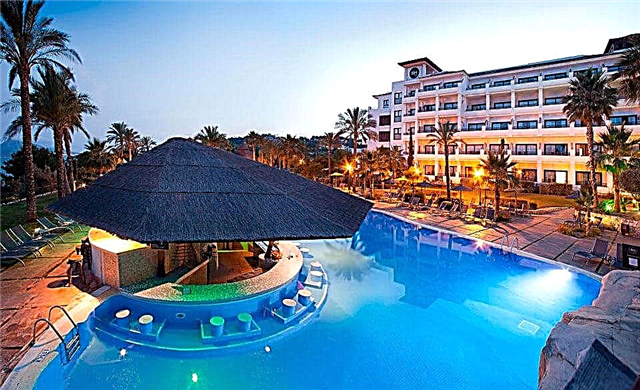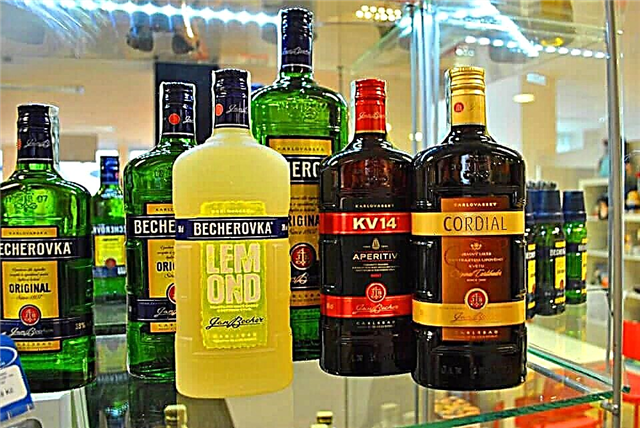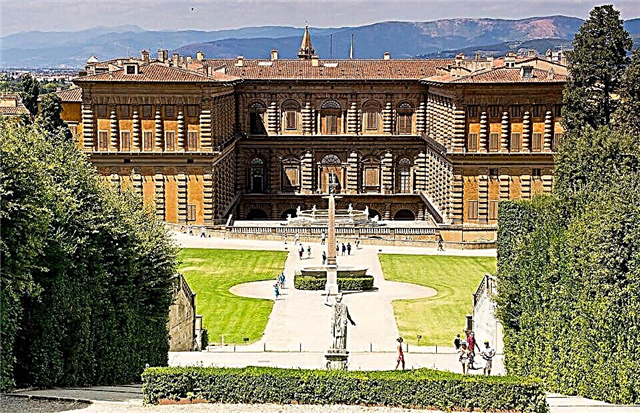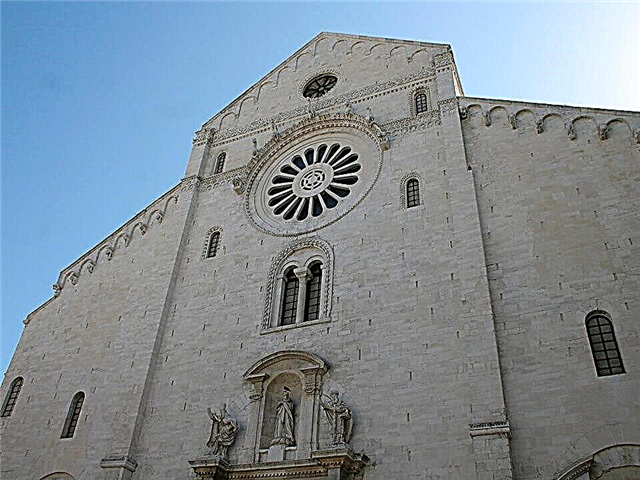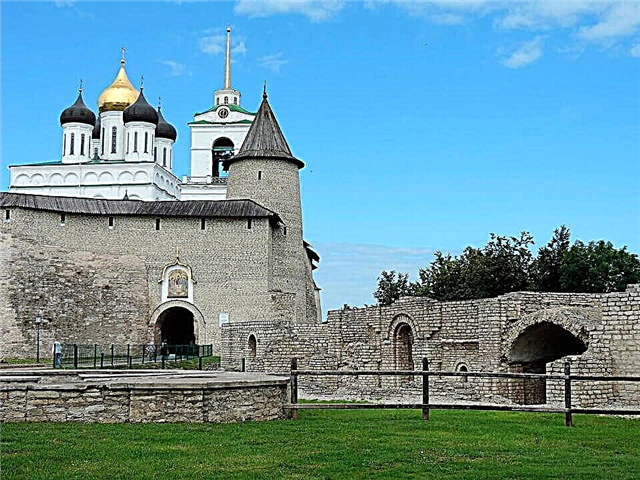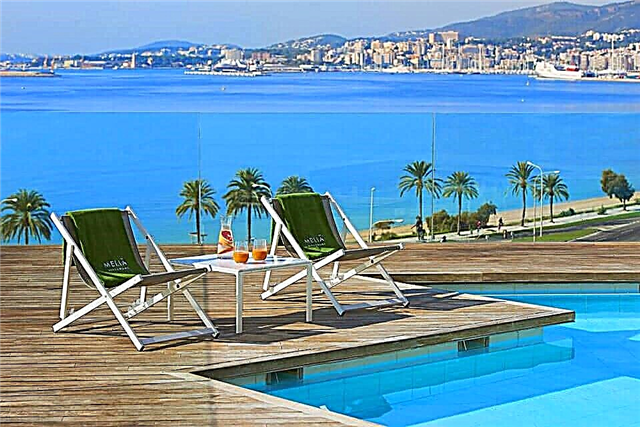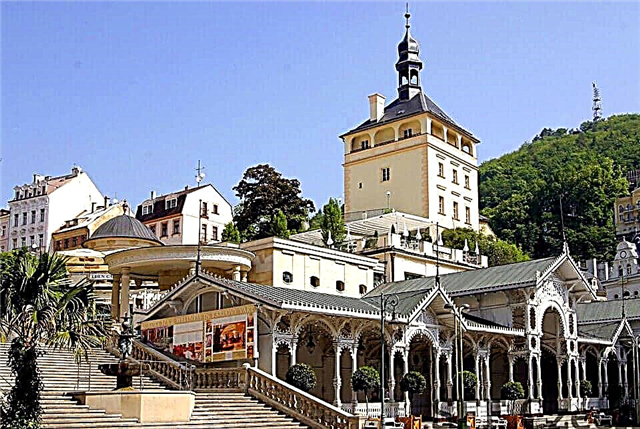What to see in Karlovy Vary in 1 day on your own, time-limited tourists are interested. And is it even possible to see anything at all: after all, the town welcomes people who have arrived for balneological procedures. Meanwhile, Carlsbad is an interesting place where all of Europe rested in the 18-19 centuries. And the city authorities strove to make the guests' stay unforgettable. Healing springs are decorated with graceful galleries, where it is pleasant not only to drink a sip or two of mineral water, but also to relax in the shade. And sometimes listen to music. Colonnades (with rare exceptions) are available throughout the day. History buffs will appreciate the ancient buildings built by the famous inhabitants of Carlsbad. It is important that the sights are located compactly: moving from one to another, you can see them in a short time.
Observation deck "Three Crosses"

This place offers a great view of the city. And the road to the top of the hill is extremely picturesque: it goes through the forest. It is especially pleasant to climb to the viewpoint at dawn: there are few tourists, it is quiet and deserted around. And the city, colored by the first rays of the sun, is remembered for a long time. The three crosses are named after the wooden crosses at the very top of the hill. But why they appeared here, there is no consensus.
Some historians claim that this is a symbol of the return of the city and the surrounding area to the Catholic faith. Others believe that this is an image of Calvary. Locals say that the crosses are a reminder of the tragic death of three brothers. At the beginning of the 20th century, it was planned to build a fashionable hotel on a picturesque hill. And she was supposed to connect with the city using a cable car.
Work began in 1912, and was stopped in 1914 due to the First World War. From this period, there were blocks to which the cable car ropes were to be attached. During the hostilities, an observation post was built on the hill. And at the beginning of the 2000s, a gazebo was erected on a concrete foundation. It stood for 3 years and was destroyed. Now a new gazebo, designed by the architect Stros, flaunts at this place.
Diana Observation Tower

If a tourist wants to see not only the city, but also its surroundings in a circle of 70 km, he should climb the Diana Tower. From here a wonderful panorama of the Ohře and Teplá valleys opens up. In sunny weather, you can see far from the site. And this point was equipped in 1804 by local residents: Drumm and Shter. They were the first to assess the capabilities of the top of the hill, cleared the road, and set up several benches for tourists. A little over 100 years later, for the convenience of climbing the hill, a funicular was launched. The arrangement and decoration of the viewpoint was continued by a local construction company erected a hunting lodge with a stone wall. It was possible to climb the wall and inspect the surroundings. The center was opened in 1914.
The tower changed its name several times:
- from the moment of construction until the outbreak of World War II, it was called the Kudlich tower (Austrian policy)
- from 1945 until the fall of the socialist system - the Benes tower (President of Czechoslovakia)
- today it is called Diana Tower
To climb to the platform, you will have to overcome 150 wooden steps. But all the work pays off with an excellent panorama of the surroundings. Nearby there is a restaurant with national cuisine, in summer you can ride a pony.
Deer Jump Observation Deck

The cliff is decorated with a statue of a chamois, although a deer jumped along the steep slopes during the hunt of King Charles 4. The first to draw attention to the discrepancy (in the local forests there are chamois that easily climb the rocks) Baron von Lutzow. He ordered to put a sculpture of a hoofed animal made of zinc on the hill. The author of the statue was August Kiss. The city council was outraged and tried to remove the chamois, but was late with the adoption of measures: the sculpture became popular.
It stood for 130 years until it was barbarously destroyed. But on the site of the zinc monument, a bronze copy was installed. The project was carried out by the sculptor Kotek. A gazebo was built on the very ridge for the convenience of exploring the surroundings. It was funded by the industrialist Mayer from Vienna. The gazebo has survived and bears the name of the founder: Mayer's gloriet.
Mlyn Colonnade

Today it is the most popular spot in the city. Tourists constantly gather here. And this is not surprising: the aerial structure rests on 124 graceful columns. It is always cool inside, so guests take refuge here from the summer heat. And excellent acoustics facilitates concerts in the colonnade. For this, a special orchestra pit has been set up. But there was a time when the townspeople were outraged by the view of the colonnade, they considered it spoiling the appearance of Karlovy Vary.
They spoke negatively about her, some even demanded to demolish such an ugly building. But tourists appreciated the unusual building: here you can listen to music for free (there are no walls that completely cover the interior space), wait out the heat. Inside there are as many as 5 sources of mineral water, from which it is offered to drink around the clock.
It is noteworthy that all sources are located compactly, you can inspect them in a short time:
- The rocky spring was known for a long time: horses were bathed in warm medicinal water. Then the key was taken out of the rock, the territory was cleared of silt and dirt.
- Libushi. He was named after the virtuous princess, whose descendants became kings.
- Prince Wenceslas. In the old days, the famous local salt was evaporated from its water. Now there are as many as 2 in the Wenceslas Gallery.
- Mlynsky. Since the 16th century, medicinal water has been sold in the city's pharmacies.
- Mermaid. It was once the most popular and was called New.
The water in all springs is hot: its temperature is over 50 degrees Celsius.
Garden colonnade

All guests of the city must visit this openwork gallery. She is in the gardens, and her appearance is associated with the veneration of Antonin Dvořák by the Karlovy Vary people. A bust of the composer is installed on the territory of the city garden. And nearby the city authorities have built a concert venue. The authors of the project were the architects from Vienna Helmer and Fellner. But after a short time, the structure was dismantled, leaving only a part. It was she who later became part of the colonnade.
As many as 3 sources emerge in the colonnade:
- Sadovy (to free the key, it was necessary to dismantle part of the wall of the military hospital)
- Serpentine (decorated in the form of a bowl into which water flows from the mouth of a reptile)
- The Spring of Freedom
Surprisingly, the water in the Garden Colonnade is cooler than in other places, and tastes better.
Market colonnade

The most permanent thing in life is temporary. The city authorities built the market colonnade to preserve the purity of the unique mineral springs: Rynochny and Karl 4. The city authorities ordered the project from famous Austrians: Helmer and Fellner. The architects used Swiss motives: the pavilion turned out to be a copy of the Alpine arbors. Surprisingly, the bizarre structure organically complemented the urban development. It was assumed that the wooden pavilion would stand for several years, and then it would be demolished or replaced with a permanent one. But the openwork gallery was so fond of the townspeople and tourists that they decided to leave it. Today the building has its original appearance.
Guests can taste water from 3 sources:
- Karla 4 (this is the oldest well in the region)
- Market (water flowed from it irregularly, additional drilling was required)
- Lower Castle (drainage of the key from the Castle Colonnade)
The Market Pavilion is available to all visitors.
Castle colonnade

This is the youngest gallery in the region: it was built at the beginning of the 20th century. The city ordered the project, and it was executed by Johann Oman, an architect from Vienna.He decided that it would be best to build a building in the Art Nouveau style, the most popular at the time. Until now, it attracts guests with its lightness and grace. Architectural historians do not remain indifferent to this building.
The pavilion keys are located above all others in the city: the flowing water has unique properties. The local spa is extremely popular with visitors to Karlovy Vary. And the place itself is amazingly picturesque: it is located on bare rocks. The gallery is decorated with a bas-relief by Wenzel Heida, Spirit of the Springs. The architect used the mineral argonite.
But today only those who are treated in the Zamkovy Lazne sanatorium can drink water from the gallery's springs: the administration of the center has banned tourists from entering the territory. You can see the Oman pavilion from the side of the Market Square. And one of the local keys is brought into the Market Gallery: Lower Castle.
Hot Spring Colonnade

The water temperature in the Geyser is close to the boiling point, and the mineralization is quite high, therefore, for the convenience of consumption, already diluted ordinary mineral water is supplied to the vases. The temperature in different fountains ranges from 30 to 50 degrees Celsius. The degree of mineralization is sufficient for medicinal purposes.
The geyser is a powerful source. From it pipes were laid to all the sanatoriums of the city. The liquid flowing through them is used for medical and cosmetic procedures. Moreover, Geyser is a supplier of raw materials for the production of the famous salt. Guests wishing to explore the Geyser should note that the gallery is open only from 6 am to 7 pm in winter, and in summer from 6 am to 6 pm.
Motorcycle Museum

To visit the exposition, you will have to take a little ride: the center is located in the village of Bečov nad Teplou. Visitors will see fifty restored motorcycles. Fans of bikes will get acquainted with original parts, which are no longer produced by factories, and accessories. The owners of the exhibition take pride in the fact that they used original parts when restoring old models.
Lovers of architecture will love the building that houses the motorcycle exhibition: it was built in the 13th century. Nearby there is a toy museum, an exhibition of edged weapons and firearms. And the very walk through the quiet village will give pleasure: the narrow streets are imbued with the spirit of antiquity. The houses are clean and well maintained, there is even a castle.
Alois Klein's Gazebo

In the 18th century, a sour spring spilled into the area that is now occupied by the Richmond Hotel. He was fenced off and named after the Erz-Duchess: Stepank. Water began to be used in medical procedures. But in the twentieth century, the key stopped beating. They were looking for him until 1993. In 1997, the vase was surrounded by a wooden gazebo. The architect Vondrachek turned to the tradition of Alpine architecture: the structure turned out to be light and airy. And they named the gazebo after the name of the first owner of Richmond: Kline (Klein).
The gazebo stands in a picturesque park with century-old trees. The air is saturated with phytoncides. The walk to the source is pleasant and rewarding. And you can drink sour mineral water at any time of the day, but it is important to remember: Stepanka does not have a certificate of registration of a natural healing resource.
Butterfly House

If the weather has suddenly turned bad, you can spend time usefully at the Butterfly House. Here, in the territory of an artificially arranged tropical forest, insects from all parts of the world are represented. Visitors are immediately taken to the flying area, which takes up as much as 100 square meters. In it, colorful beauties feel at ease, whose wingspan reaches 20 cm. Sometimes they sit on the shoulders or arms of tourists. In the center, it is allowed to take pictures and take pictures.
A separate area is set aside for an incubator: in it, butterflies hatch from pupae. It is a breathtaking sight. Information boards with descriptions of the habits of the inhabitants of the pavilion are placed along the path. If you're lucky, you can witness a romantic wedding ceremony. Some lovers come to Karlovy Vary especially for this. And souvenirs are sold at the reception. The house is open every day from 10 am to 5 pm (in high season - until 7). The administration of the center notifies in advance about the change in the working schedule.
Church of St. Mary Magdalene

The church is conveniently located: not far from the Hot Spring. The gallery is still visible from the steps. The modern temple is a fairly new building. And the first, founded by the Order of the Knights, arose here in the 14th century. In the 16th century, the building was rebuilt, taking into account the increased number of parishioners. But the church stood for a little over 100 years and died in a fire. In the 18th century, the townspeople again had to erect a completely new building on the old ashes. The work was complicated by the presence of a nearby powerful source of mineral water.
But everything ended well: after 3 years the first Mass was celebrated. And today the Church of St. Mary Magdalene amazes with splendor. Inside, the architects used the technique of wood carving. Wooden painting is also presented. The ashes of the deceased, who rested in the old cemetery, were transferred to the crypt. Tourists are allowed access here. You can inspect the interior of the cathedral at any time. During the visit, respect for the feelings of the believers is required. Organ music concerts are held in the cathedral. The schedule of events is posted on the information board of the temple.
Orthodox Church of St. Peter and Paul

This temple is interesting because it was built for Orthodox Russians who came to the Karlsbad resort. The initiator was the Grand Duchess Elena Pavlovna, she also organized the initial fundraising. Donations were made by Shuvalov, Vorontsov, Koshelev. The City Council has allocated a building site: a plot on Schlossberg Street. The project was ordered from the famous Russian architect Konstantin Ukhtomsky. But the money raised was not enough to start work, so the Carlsbad authorities allowed an Anglican church to be built on the allocated site.
The Orthodox community was offered to buy part of the Pupp Grand Hotel. A house church was set up in several rooms. But the community grew, so they soon returned to the project of Konstantin Ukhtomsky. By this time, the board of trustees chaired by the Russian finance minister had raised enough funds to build its own building. The work was carried out for 4 years: the consecration took place at the end of the 19th century. Under the new church, the Turgenev Foundation was formed, and then the Russian House.
In 1914, the abbot of the temple was arrested, and only the intervention of King Alphonse saved him from execution. And after the October coup, the ministers of the Russian Orthodox Church who fled from the Bolsheviks settled in the priest's house. Today, tourists can admire the cathedral's whimsical architecture. It recognizes the motives of Russian architecture of the 16th century. And inside the walls are decorated with magnificent frescoes depicting Basil the Great, John Chrysostom. The faces of the locally revered saints are also recognizable: Vladislav and Lyudmila.
Anglican Church of St. Luke

The cathedral is located in the very center of the resort town: on the slope of the Castle Hill. The church is easily recognizable by its unplastered red walls, which emphasize the origin of the building. Carlsbad was visited by the inhabitants of Foggy Albion for rest and treatment. They spent several months at the resort, so a church had to be built. The existing temple was small and could not accommodate all the parishioners, so it was demolished.
The new cathedral was designed by the Carlsbad architect Josef Slovak. The work was carried out for a short time: about 2 years. The consecration of the temple took place at the end of the 19th century. Services in the cathedral were held until the beginning of the 20th century. Then the building was restored. By the decision of the owner (the Methodist Church), the services ceased. But you can still inspect the interiors of the building: there is an exhibition of wax figures in the Church of St. Luke.
Visitors will not only see a unique exhibition of historical figures from Madame Tussauds, London, but also appreciate the building's original vaults, carved ceilings and original stained glass windows from the 19th century.
City theater

Already at the beginning of the 18th century, the authorities of Carlsbad started thinking about organizing leisure activities for vacationers. And for the entertainment of the aristocrats, she built a theater of wood. But a big fire completely destroyed the building. Therefore, it was decided to build a permanent stone theater. The project was ordered from the Viennese architectural bureau of Helmer and Fellner. The works of architects demonstrated the ability to link buildings with existing buildings and landscape.
And today tourists can appreciate the success of the builders: the city theater is the pearl of Karlovy Vary. The interiors of the building are impressive: there is hardly a curtain of paintings anywhere else. It consists of 8 paintings by artists. And depicted on the curtain is a poet surrounded by muses. Each of the girls inspires him for a special kind of creativity. The curtain was created by the brothers Klimt and Franz Match.
And the Klimt sisters served as models for the muses. The same artists painted the ceiling and walls of the auditorium. Separately, it should be said about the engineers: all the novelties of the 19th century were used in the hall. The acoustics are great. Today the interiors (including the curtain) have been completely restored. And you can admire the wonderful design of the auditorium during the performance, which takes place in the theater on a regular basis.
Villa "Luttsov"

Baron von Lutzow first visited Karlsbad as a rather elderly man: he was 50 years old. The goal is common: water treatment. But von Lutzoff liked the city so much that he decided to settle here permanently. The rich man liked to make himself comfortable: on the day from the sale of property in his homeland, he built a luxurious villa. The park is especially noteworthy: here terraces, promenades, gazebos and pavilions were fancifully combined. On the territory there are also sculptures of animals: a bull, a cat, a deer, dogs and a horse.
Especially noteworthy is the image of the cat. Von Lutzow was in constant confrontation with the city council. The caustic baron commented on the strange (in his opinion) decisions of the administration. After the statue of King Charles 4 was installed in the central park, a cat appeared on the territory of the villa, sitting on a huge pedestal with its back to the city council building. I must say that the sculpture of the monarch in the park stood on a powerful pillar.
The disrespectful cat in its pose spoke to the townspeople:
- the king is given less attention than the base of the monument
- the monument itself is of interest exclusively to local authorities
- sculptor - complete mediocrity
- von Lutzow is outraged by this interpretation of the king's merits
Unfortunately, it is hardly possible to walk along the paths of the villa and see the legendary cat today: the new owners have closed access to tourists to the territory. But you can look at a part of the park from behind the fence from the street.
Castle tower

The tower is located in the historical center of the resort: a wonderful view of the Castle and Market colonnades opens from here, and the famous Geyser is just a stone's throw away. This is a fairly new building. It was erected to replace the old one left over from the castle of King Charles 4. On the site of a hunting lodge in the forest, the monarch ordered to build a castle. But in 1604, a strong fire completely destroyed the structure. One tower remained intact. But the preferences of the townspeople changed, the baroque style came into fashion.
The surviving tower was demolished, and a new one was erected on its foundation. Immediately, a tradition arose: to meet eminent visitors of the town with fanfare, distributed from the Castle Tower. Some highly esteemed persons are greeted in the same way today. The tower houses an excellent restaurant serving national Czech cuisine. They serve excellent meat prepared according to old recipes and local cheese. It's nice that the prices in the restaurant are quite affordable.
Orthodox chapel of St. Nicholas

Nicholas Stepanov, a native of Russia, built the chapel of St. Nicholas with his own money. The project reveals the traditions of Russian wooden architecture. The chapel was assembled on the spot (in Russia), then the frame was numbered and sent to Karlovy Vary. Reassembly took place on Doubskaya Mountain. In November 2000, Archbishop Christopher consecrated the chapel. But the services did not last long: today the chapel is closed for believers. But from the Doubska mountain, beautiful views of the surroundings open up, and the wooden tracery building organically blended into the local landscape. Tourists still come here.
Jan Becher Museum

Patients from all over Europe came to Carlsbad to recover with the help of healing waters. And everything in the city was done to ensure that the treatment was successful, and the rest was remembered for a long time. And when a herbal tincture with alcohol began to be sold in Becher's pharmacy, this did not surprise anyone.
But very guests of the resort appreciated the wonderful taste, and the medicinal preparation became popular in all countries. The name of the drink was given by the name of the author: Becherovka. More than 200 years have passed since that time, and everyone still likes the liqueur: every tourist brings a bottle of Becherovka as a souvenir.
The popularity of the drink prompted Jan Becher's successors to create a museum. Here are:
- branded packaging (bottles, flasks, beakers and cardboard boxes) used for liquor in different years
- labels with the manufacturer's logo
- branded dishes (glasses, beakers, cups)
- liquor ad
- samples of fakes of a popular drink
Visitors will be shown the cellars where the wonderful liqueur is prepared, and they will also tell how Jan Becher came up with the recipe. Will demonstrate linen bags with secret ingredients. Most of the components are assembled in the county, but some have to be imported. But no one will ever divulge the secret recipe: the trademark owners guard it carefully.
Incredibly, several people know the exact list and number of elements. And the event ends with a tasting of the amazing Becherovka. You can buy a drink as a souvenir or as a gift to your friends in the company store located nearby. You can visit the museum every day from 9 am to 5 pm.
Moser Glass Museum

150 years ago in Europe, every royal court had dishes made at the Ludwig Moser factory. And despite the high price, noble families tried to acquire beautiful and fashionable sets of the famous manufacturer. And today, Moser's products are popular. Tourists who come to Karlovy Vary seek not only to buy a souvenir made of colored glass as a keepsake or as a gift, but also to visit the exposition.
Exhibition visitors will see:
- types of colored glass products produced at the factory for 150 years
- antiques, once mass-produced, but now available in single copies
- modern and fashionable product samples
In total, more than 1000 storage units are exhibited in the halls of the plant. But that's not all.
Guests can visit the glass-blowing shop, where they will be introduced to:
- with samples of raw materials
- types of molten glass
- the process of converting an undefined starting material into an exquisite glass product
- tools and technologies used for different types of products
But the final stage of production (final design of products) remains behind the scenes. On the other hand, visitors have the opportunity to visit the branded product store, which is also very interesting. Here you can not only buy your favorite glass product, but also make engraving on it if you wish. Tired and hungry sightseers will gladly dine at the signature cafe Moser, from the terrace of which an amazing panorama of Ludwig Moser Square opens in summer.
An unusual fountain was built on it, which is surrounded by crystal figures produced at the Moser factory. The museum is open to the public during the week from 9 am to 5 pm.But excursions to the glass-blowing shop are made from 9 am to 3:30 pm. The shop and cafe stop working at 6 pm.

